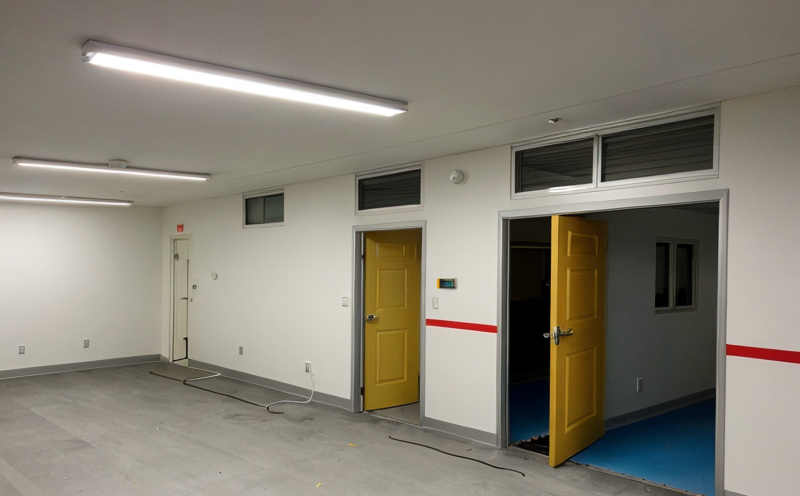UL 8750 LED Module Safety Testing for Emergency Lighting
The UL 8750 standard is a comprehensive guide to ensuring the safety and reliability of emergency lighting systems. Specifically, this test evaluates the performance, durability, and safety of LED modules used in emergency lighting applications. This stringent testing protocol aims to safeguard public safety by verifying that these critical components meet rigorous electrical, mechanical, thermal, and environmental standards.
UL 8750 is designed for a variety of products including exit signs, fire alarm systems, and other emergency lighting fixtures. The test parameters are meticulously defined to ensure that the LED modules can withstand real-world conditions such as power surges, overcurrents, high temperatures, and humidity. These tests simulate the stresses these components might encounter during their operational life in a building or facility.
The testing process involves several stages where the LED module is subjected to various stressors. The first stage typically involves electrical testing to ensure that the module can handle the specified input voltage without overheating or short-circuiting. This step ensures that the product operates safely under normal conditions and does not pose a fire risk.
The second phase focuses on mechanical stability, where the module is tested for its ability to withstand physical abuse such as dropping from heights or exposure to vibrations. This part of the test evaluates the robustness of the LED module design to ensure it remains functional during installation and operation in a challenging environment.
Thermal testing constitutes another critical aspect of UL 8750 compliance. Here, the LED module is exposed to elevated temperatures for extended periods to observe its response to heat stress. This ensures that even under extreme conditions, the module continues to function correctly without compromising safety or performance.
Finally, environmental conditioning tests assess the LED module's resilience against humidity and other environmental factors. These tests mimic real-world weather conditions to ensure the product remains operational in various climates.
The UL 8750 testing process is not just a set of mechanical and electrical evaluations; it involves a holistic approach that considers all aspects of safety, durability, and performance. Compliance with this standard ensures that emergency lighting systems meet stringent international requirements for public safety and compliance.
- Electrical Testing: Ensures safe operation under specified input voltage.
- Mechanical Stability: Evaluates robustness against physical abuse.
- Thermal Testing: Guarantees reliability in high-temperature conditions.
- Environmental Conditioning: Tests resilience to humidity and other environmental factors.
The importance of UL 8750 LED module safety testing cannot be overstated. It provides peace of mind for quality managers, compliance officers, R&D engineers, and procurement teams involved in emergency lighting systems. By adhering to this standard, manufacturers can ensure their products meet the highest level of safety and reliability.
Why It Matters
The UL 8750 LED module safety testing for emergency lighting is crucial because it ensures that critical components in these systems are safe and reliable. In an emergency, such as a fire or power outage, the failure of any part of the emergency lighting system can have catastrophic consequences. Therefore, ensuring compliance with this standard is not just a matter of regulatory adherence but also a responsibility to public safety.
Emergency lighting systems must function reliably in critical moments when they are needed most. By undergoing UL 8750 testing, manufacturers can demonstrate their commitment to quality and safety. This certification provides stakeholders—such as building owners, facility managers, and local authorities—with assurance that the products meet the stringent standards set by this international standard.
The real-world impact of this testing is significant. In a fire or other emergency situation, every second counts. Reliable emergency lighting systems can provide the necessary illumination to guide people to safety, reducing panic and confusion. This not only enhances public safety but also minimizes potential injuries and property damage.
Moreover, compliance with UL 8750 helps manufacturers avoid costly recalls and product liability issues. By ensuring that their products meet these rigorous standards, companies can build a strong reputation for quality and reliability, which is essential in the competitive lighting market.
Why Choose This Test
Selecting UL 8750 LED module safety testing offers several advantages for manufacturers of emergency lighting systems. This comprehensive test ensures that your products meet the highest standards of safety and reliability, which is crucial in critical applications like emergency lighting.
The first advantage is regulatory compliance. Meeting this standard helps ensure that your products are legally compliant with international regulations. This is particularly important in regions where strict safety standards are enforced for emergency equipment. UL 8750 provides a clear pathway to certification, making it easier for manufacturers to navigate the regulatory landscape.
Another key advantage is enhanced product quality and reliability. The rigorous testing process involved in UL 8750 ensures that your products are robust enough to withstand real-world conditions. This can lead to longer product lifespans, reduced maintenance costs, and improved customer satisfaction. By ensuring that your LED modules perform consistently well under various stressors, you can build a reputation for producing high-quality products.
UL 8750 also provides a competitive edge in the market. In an industry where safety and reliability are paramount, being able to demonstrate compliance with this standard can set your products apart from competitors. This certification can be a powerful marketing tool, allowing you to communicate effectively with customers about the quality and safety of your emergency lighting systems.
Furthermore, this testing process offers valuable insights into potential product improvements. By identifying any shortcomings during the testing process, manufacturers can make necessary adjustments to enhance product performance and reliability. This proactive approach not only improves product quality but also reduces the risk of failures in critical situations.





